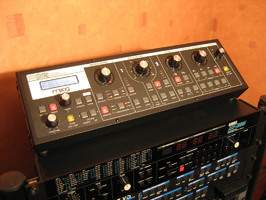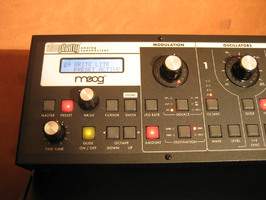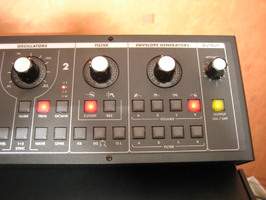Five years after having introduced the Little Phatty, Moog decided to launch the compact synth in module version. Did the Slim Phatty succeed in making the famous Moog sound available to anyone?
The Little Phatty is the last project of the late Bob Moog who passed away in August 2005. A few months before passing way, he recruited Cyril Lance who finished the work of his master. The first Little Phatty saw the daylight for the first time at the Frankfurt Musikmesse in March 2006. The unit is a mix between a Prodigy and a Source, two synths based on the Minimoog D and developed in the early 80's. In fact, the Little Phatty resembles the Prodigy in its looks and the use of two VCOs, but it takes advantage of the memories and programming method of the Source. In late 2010, Moog Music announced an affordable Little Phatty module. Don’t be fooled — affordable Moog means under $1000. Is the Slim Phatty the small synth everyone was waiting for?
Lightweight
The Slim Phatty is Moog’s “feather-light” analog synth, considering that it weights less than 6.6 lb. and is 20" width. Its fully metallic construction is very solid and even if the metal sheets are slim, they don’t bend easily. Like all Moog products, the housing was not screen printed but coated with Lexan instead. The front panel features not less than 34 switches with LEDs (some of them are two-colored, red/orange, depending on the status of the device), four big controls surrounded by 15 red diodes (which show the value of the parameters assigned), two standard controls (a bit too responsive) for tuning and volume setting, one push-encoder for value setting, program selection and browsing), and 18 LEDs. The controls and encoders are a bit loose, so they don’t feel as solid as the ones on the Voyager. A 2×16 light blue LCD display shows additional parameters while editing or playing.
The connections on the rear panel are a bit recessed, which allows you to mount the unit on a standard 19" rack without any cable problems. The unit requires 3U in a 19" rack. As it is always the case with Moog, the device is equipped with high-quality connections firmly screwed to the housing. You get one USB connector, one phones out, one mono audio out, one audio input, four CV/Gate ins, MIDI in/out/thru, a power switch, and a power connector (universal internal power supply… thank you!). The type-B USB connector only transfers MIDI signals. The CV/Gate inputs allow you to control the Slim Phatty with an external analog controller (foot controller, modular synth, sequencer, Theremin, etc.): they are connected to the pitch (CV), filter (CV), volume (CV) and keyboard (Gate). It’s a pity that Moog didn’t provide optional CV/Gate outs like on the Little Phatty: they would make the Slim Phatty the perfect USB–Midi–CV/Gate converter. It’s also a pity that Moog placed the phones out on the rear panel while it was conveniently placed on the front panel of the Little Phatty…
Easy to Understand
The Slim Phatty stands on rubber feet placed at a 45 degree angle, which is very convenient for editing. The handling and design are very similar to the Little Phatty — the front panel is the same except for the phones out, and the fact that it’s more compact. The different sections are easily recognizable and logically designed. From left to right you have: master (modes, menus, programs, tuning), modulation, oscillators, filter, envelopes, and audio out. The programming mixes analog architecture (one control = one function) with a common center control. Each of the four main synthesis sections features several buttons for parameter selection and a big control for value setting. This concept ensures a fast and effective use. To keep everybody happy, Moog incorporated different response modes for the potentiometers (step, threshold, relative). The only ones disappointed will be endless encoder fans…
Some clever features make it easier to use the synth. For example, when you press the encoder beneath the display, you can switch between submenu pages or browse programs 10 by 10. The program selection loops at the end of the list so that you can easily toggle between the last one and the first one. As soon as you engage a control, the LCD indicates that you have entered edit mode and the Preset button changes color. Now, you just have to push it to toggle between the stored preset and the preset you are editing (Edit/Compare function). On the other hand, the values of the edited parameters cannot be read on the display… Another clever feature is that the internal synthesis parameters and external MIDI CC sent by the four main controls can be redefined for each program. This allows you, for example, to control the cutoff and resonance of the filter with two separate pots.
|
The controls on the front panel don’t allow you to edit certain synthesis parameters of the programs like filter poles, selection of some modulation sources/destinations, arpeggiator… To edit these parameters, you’ll have to use the Preset menu. You can browse this menu using the browsing keys (Cursor/Enter) and the encoder beneath the LCD. To quickly transpose +/-2 octaves, use the dedicated multicolor Octave Down/Up keys. The unit is provided with a CD-ROM that includes the manual in PDF format and the microtonal scale editor software (see text box). If you want the PC/Mac editor (VST or stand alone version), the rack mounting kit or the wooden side panels, you’ll have to pay an additional handful of dollars…
Extra Fat!
The Slim Phatty is a monophonic analog synth that uses the same audio engine as the Little Phatty. It provides 100 user memory locations with 100 factory presets. The typical Moog sound quality is definitely included: roundness and punch for resonant bass sounds and saturated leads. The factory presets provide many bass and lead sounds you can listen to in the sound samples. The sound is generated by two analog oscillators, which can be tuned across nine octaves. The oscillators are the same as on the Voyager. They can generate triangle, rectangular, sawtooth, and square waveforms (as well as everything in between), which can be simultaneously modulated. You can also generate PWMs by modulating the waves between square and rectangle. The width of the wave can be so narrow that it becomes silent. The second oscillator can be detuned from a few cents to +/-7 halftones and synced with the first one. This is the only possible interaction between the two oscillators, which means: forget about ring modulation or FM. Also notice that this section includes no noise generator, so the Slim Phatty was not conceived to create wind easily! A Glide parameter allows you to set the portamento speed between two notes.
The oscillators provide separate level settings before the signals reach the filter section where they are mixed with the external signal feeding the dedicated audio input. The filter type is a Moog low-pass that can work with 1, 2, 3 or 4 poles. This parameter can be accessed via the menu and stored in each program. The response of the filter is extremely smooth from 20 Hz to 16 kHz. The reason is that the CVs (control voltages) produced by the four potentiometers with LEDs control analog components before being converted into digital data in oder for them to be stored in the memory locations. The presets have a default 12-bit resolution (4,096 possible values), but it can be modified by the user. The MIDI resolution for DA conversion can be set to 7 or 14 bits (up to 16,384 possible values). This applies to all oscillators, filter and envelope continuous values. The cutoff frequency has a continuous note-track feature (from 0 to 100%) and a bipolar modulation via a dedicated envelope. Note that the Glide takes the note-track into account. When you increase the resonance, the filter can be self-oscillating. Finally, the Overload parameter (with a continuous range from 0 to +6 dB) allows you to create a feedback loop within the filter, which ranges from a subtle saturation to a very aggressive metallic-sounding distortion. Sweet!

- bass101:15
- bass200:45
- lead100:22
- lead200:22
- lead arp100:22
- lead arp200:23
- lead solo00:40
- lead seq00:34
- lead n wind00:38
- tempest00:56
Limited Modulations
To modulate sound, the Slim Phatty offers two ADSR envelopes that are pre-assigned to the filter cutoff and the master volume. The time ranges from 1 ms to 10 seconds. Since these envelopes are very fast, they give the Slim Phatty a great punch. The modulation section allows you to assign one modulation source to two destinations while staying in the analog realm. The sources include an LFO with four waveforms (triangle, square, upward sawtooth, downward sawtooth), the filter envelope, the VCO2, a Sample & Hold generator, a noise generator… The LFO works up to 500 Hz, which allows for FM-like modulation effects (bell sound). It can be synced to the MIDI clock using a time divider with 15 different values. You can use the noise generator to partly replace the noise parameter that is not provided in the VCO. To do so, proceed as follows: set the destination VCO2 to 0 (otherwise you won’t hear the noise), set the waveform pulse to 0 (otherwise you’ll hear the pitched VCO) and choose the desired pitch octave amount to determine the noise color…
As destinations you have the global pitch, the waveforms (for both VCOs simultaneously), the filter cutoff and the VCO2. The first destination can be directly selected from the front panel, the second one via the menu. The modulation amount can be adjusted, while the final modulation is set by the modulation wheel like on the Prophet-5. The velocity control is assigned only to the filter (over a -/+8dB range)… Hm! And that’s it for modulations — certainly much less flexible than a Voyager in terms of possibilities and routing. We understand that Moog decided to lighten this section to offer an affordable product without compromising sound quality, considering that modulation makes analog circuitry always more complex.
Arpeggios and MIDI
However, the Slim Phatty surpasses the Voyager when it comes to arpeggios – it has an arpeggiator, which the Voyager doesn’t. The parameters are stored in each preset and accessible from the menu. The arpeggiator provides no direct controls except on/off and tempo. The tempo can be synced to the LFO speed or to the MIDI clock (15 time subdivisions identical to the LFO). It can also be independent. It can be used in a range from –3 to +3 octaves around the reference tone. You get three patterns (up, down, order) and three playing modes (loop, back/forth and once). Unfortunately, there is no random mode…
The notes generated can be sent via MIDI. A Latch function allows you to keep the arpeggiator working after releasing the keys. You can even decide if it should keep on going when you change programs. And since we are talking about program changes: you can organize the 100 internal memory locations in 32 performance sets which are ideal to find your programs very quickly during a live performance or a studio session.
Conclusion
The Slim Phatty is the most affordable Moog synth ever. Described and marketed as the antithesis of the luxurious Voyager XL, it still provides the typical Moog sound without making you go bankrupt. It is well thought-out, very simple to use and easy to transport. However, there are sacrifices to be made: it has no directly accessible noise generator nor a comprehensive set of modulations. Nevertheless, for studio or live musicians who want to add the typical Moog sound to their setup without mortgaging their house or having to stack modules in order to build an analog polyphonic Moog, the Slim Phatty is a very nice solution that combines a real analog sound with an affordable price.







